Tom's Hardware Verdict
The Dough Spectrum Black 27 costs a bit more than similar OLED monitors but offers premium build quality, stellar gaming performance and a Gorilla Glass layer which no one else has. It’s a pleasure to use for both work and play.
Pros
- +
Stunning image made sharper with Gorilla Glass
- +
Pro-level color accuracy with no calibration required
- +
Bright highlights in both SDR and HDR content
- +
Tons of options to fine-tune the image and video processing
- +
Stellar gaming performance
Cons
- -
Smaller color gamut than competitors
- -
Expensive
Why you can trust Tom's Hardware
If I had to use a single adjective to describe OLED gaming monitors, it would be “precise.” I have found them to be colorful, accurate, and fast, almost to a fault. The differences between them are minor — refresh rates, color gamut volumes, and adherence to D65 color temp and 2.2 gamma — none stray too far from correctness. The main decision to make is, what size or shape do you want? If it’s a 27-inch 16:9 flat QHD screen, you can expect to pay around $800 for a mainstream brand.
Dough is a brand that is not mainstream but still needs to maintain high precision in its products. A while back, I checked out its 4K offering, the Spectrum ES07D03, and found it to be one of the best gaming screens at the time, with superb video processing and extreme attention to detail.
Now, there is an OLED screen from Dough that goes beyond the norm with a Gorilla Glass front layer and everything one could want for gaming and productivity. The Spectrum Black OLED is a 27-inch 16:9 flat panel with QHD resolution, 240 Hz, Adaptive-Sync, HDR400 and wide gamut color. It also has pro-level color accuracy out of the box, and the same premium game performance Dough is known for. Let’s take a look at this contender for inclusion among the best gaming monitors.
Dough Spectrum Black 27 Specs
| Panel Type / Backlight | Organic Light-Emitting Diode (OLED) |
| Row 1 - Cell 0 | Gorilla Glass |
| Screen Size / Aspect Ratio | 27 inches / 16:9 |
| Max Resolution and Refresh Rate | 2560x1440 @ 240 Hz |
| Row 4 - Cell 0 | FreeSync: 48-240 Hz |
| Row 5 - Cell 0 | G-Sync Compatible |
| Native Color Depth and Gamut | 10-bit / DCI-P3 |
| Row 7 - Cell 0 | HDR10, DisplayHDR 400 |
| Response Time (GTG) | 0.03ms |
| Brightness (mfr) | 450 nits SDR |
| Row 10 - Cell 0 | 1,000 nits HDR |
| Contrast | Unmeasurable |
| Speakers | None |
| Video Inputs | 1x DisplayPort 1.4 w/DSC |
| Row 14 - Cell 0 | 2x HDMI 2.1, 1x USB-C |
| Audio | 3.5mm headphone output |
| USB 3.1 | 1x type C up |
| Row 17 - Cell 0 | 2x type C and 2x type A down |
| Power Consumption | 39.5w, brightness @ 200 nits |
| Panel Dimensions WxHxD w/base | 23.8 x 17.9-22.9 x 9 inches (605 x 455-582 x 229mm) |
| Panel Thickness | 1.4 inches (36mm) |
| Bezel Width | Top/bottom: 0.4 inch (11mm) |
| Row 22 - Cell 0 | Sides: 0.3 inch (7mm) |
| Weight | 18.1 pounds (8.2kg) |
| Warranty | 3 years limited |
| Row 25 - Cell 0 | 2 years burn-in |
It’s apparent right off the bat that the Spectrum Black 27 is not a me-too product. Many 27-inch OLEDs are the same; indeed, they are all based on the same LG part. But Dough doesn’t stop there. This one has a unique feature in its Gorilla Glass front layer. While all OLED screens have some type of glass in front, Gorilla Glass is on another level of hardness and optical clarity. The coating used is glossy but good at rejecting reflections.
Resolution is QHD, 2560x1440 pixels, with an HDR400 certification. In practice, HDR highlights can hit 1,000 nits in areas smaller than 3% of the image. I saw nearly 800 nits when measuring a 25% window in my tests. The Spectrum Black 27 is a bit brighter than some of the competition. The Gorilla Glass layer contributes to the perception of deeper blacks as well. Though this is a subtle effect, I could see in a side-by-side comparison that the Spectrum Black 27 was a tad blacker than an Alienware AW3225QF. However, this observance is an effect of the environment, not something I could measure.
The Spectrum Black 27’s single weakness is its color gamut volume. While it is a colorful 94.04% of DCI-P3, it is a bit behind monitors with a Quantum Dot layer, which have now topped 100% in my color volume tests. The difference is negligible in practice, but it is visible.
In gaming performance, the Spectrum Black 27 is nearly untouchable. At speeds over 200fps, it renders perfect motion resolution. That is, moving objects have the same clarity as stationary ones. It’s easy to see in tests and gaming, where there is absolutely no motion blur. Dough has included a black frame insertion option to help maintain that smoothness under 200fps. It operates up to 120 Hz and has variable strobe frequency, so you can fine-tune the monitor to your graphics hardware.
Get Tom's Hardware's best news and in-depth reviews, straight to your inbox.
What else do you get? There are aiming points and frame counters. There are a myriad of tweaks for video processing and image parameters. You can pick between DCI-P3, Adobe RGB, and sRGB color gamuts. There are also color temps and gamma presets. The only two things I didn’t find were LED lighting and internal speakers. However, there are many USB ports, four USB-C plus two USB-A, along with DisplayPort 1.4 and two HDMI 2.1. Build quality is as good as it gets, with a stout metal stand and premium materials used throughout.
How much is all this goodness? The Spectrum Black 27 is $1,099 with Gorilla Glass or $899 with a matte front layer. The stand is an extra $99.
Assembly and Accessories
Dough provides an excellent unboxing experience with only cardboard that protects the contents. Delicate bits are wrapped in a smooth material that’s a bit like parchment paper. The stand comes in a separate carton and is optional. It costs $99 extra. There are no cables included except for the external power brick. I’ll leave opinions on that up to the reader.
Product 360

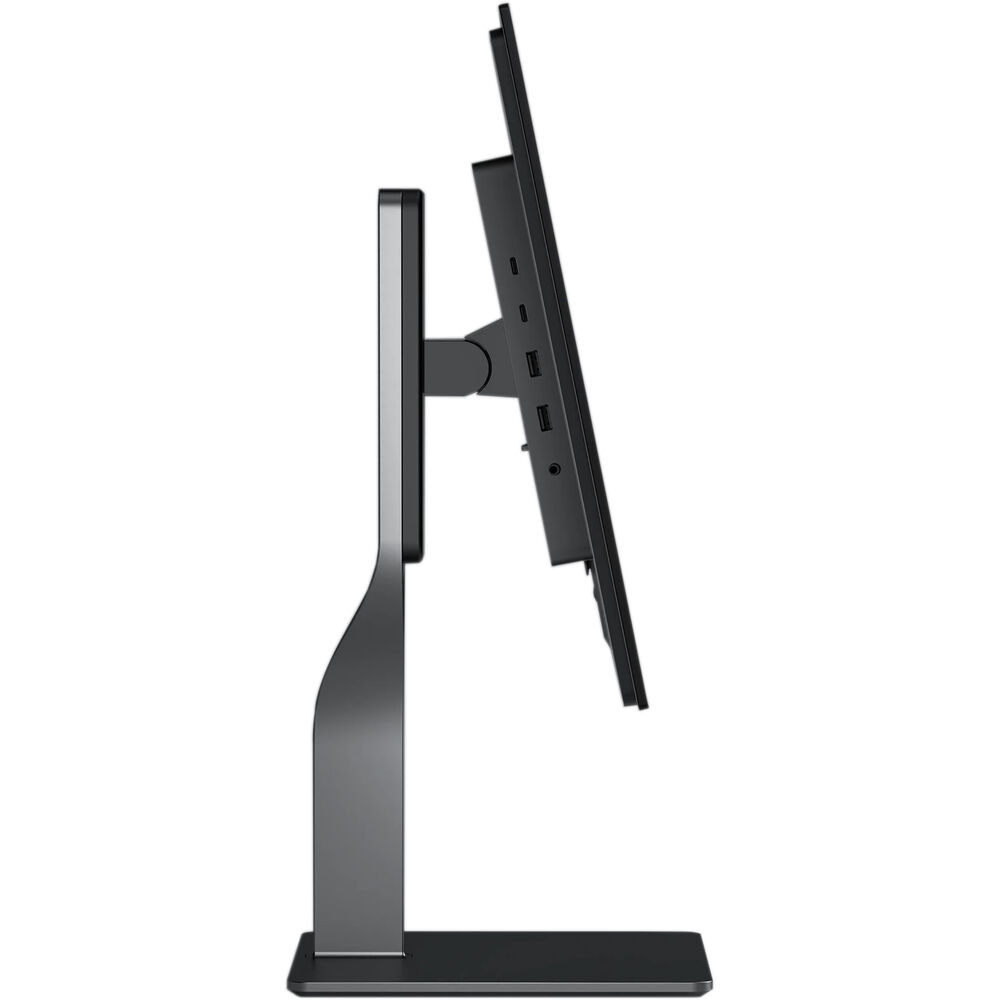
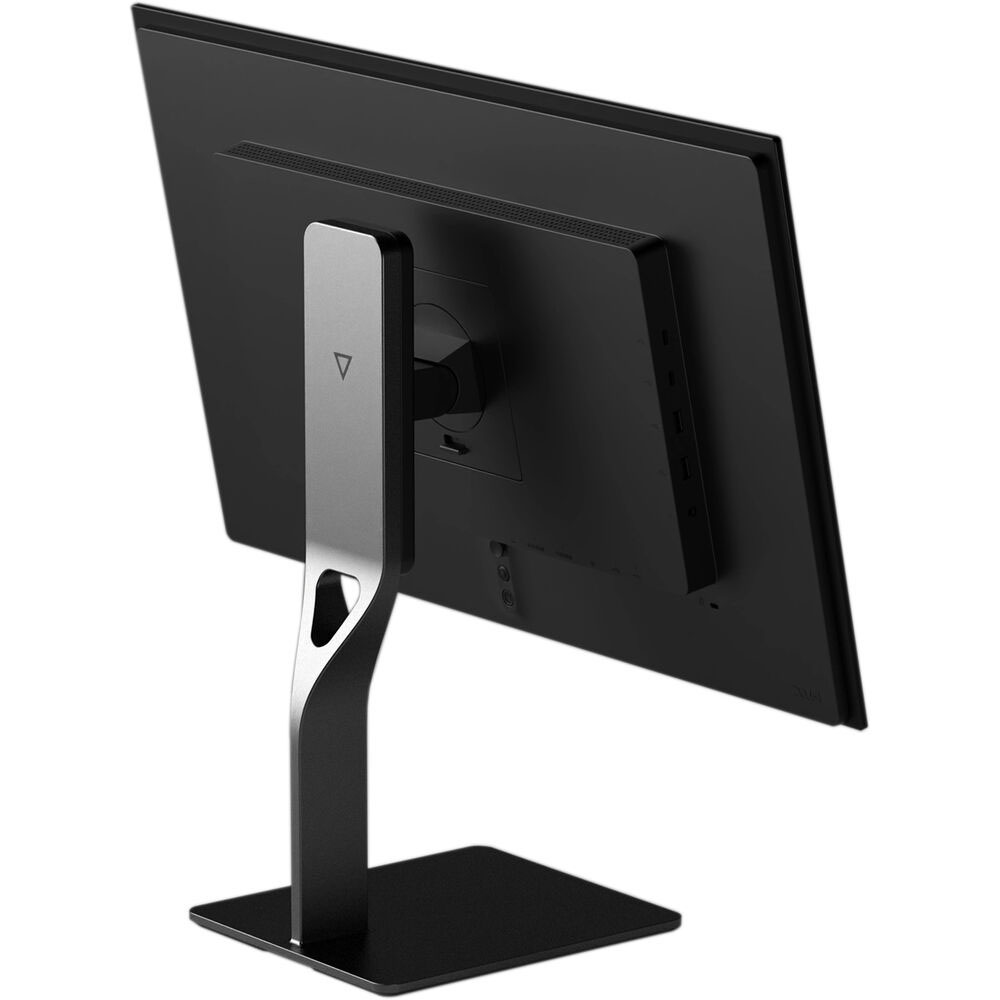
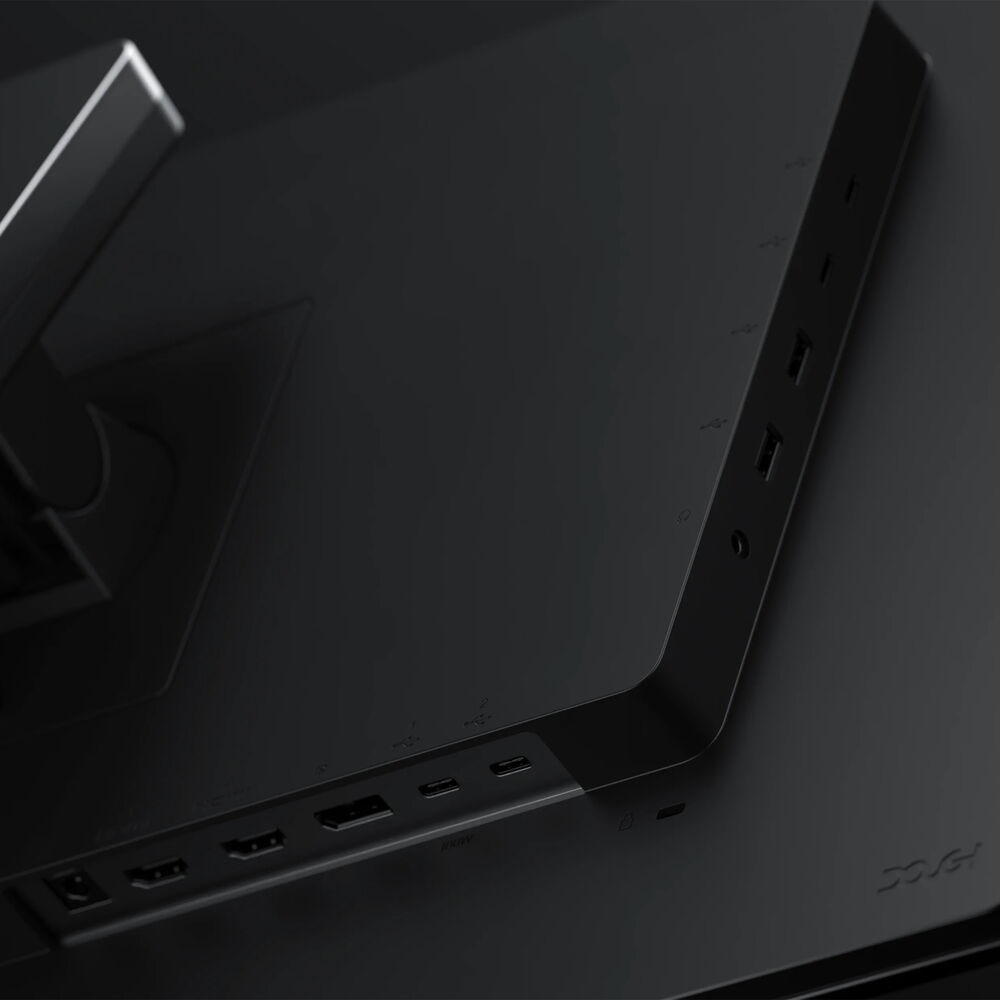
The Spectrum Black 27 has one of the narrowest bezels I’ve seen yet, just 7mm on the sides and 11mm on the top and bottom. The Gorilla Glass is visibly clearer and blacker than other OLEDs I’ve reviewed. It also has a slick finish that resists fingerprints like a smartphone or tablet. It is shiny but not too tricky to set up. I didn’t see any reflections significant enough to affect the stunning image. It is incredibly sharp and clear, definitely a bit better than the norm.
The panel is simply styled with a relatively thin component bulge in the back. Ports and vents are arranged around its perimeter. The screen’s frame is metal, while the remaining parts are plastic finished in a smooth matte. The stand is a slender and elegant piece, all metal, finished in a dark gray, with a heavy base to keep everything locked down. The Spectrum Black 27 costs a bit more than its competition, but it also delivers a more premium feel. Ergonomics include a five-inch height adjustment, 7/23 degrees tilt, and 90-degree portrait. You can rotate the panel in either direction. There is no swivel adjustment. The stand is smooth and firm, which befits this premium display.
The input panel is on the bottom and left side of the bulge in the back. Video ports include two HDMI 2.1, one DisplayPort 1.4 with Display Stream Compression (DSC), and a USB-C. A separate USB-C input handles data up to 10Gbps. USB outputs include two USB-C and two USB-A, version 3.1. You also get a 3.5mm headphone jack. Control is via a joystick with discrete buttons for power and KVM switching.
OSD Features
To summon the Spectrum Black 27’s OSD, press the joystick once to reveal an all-business text-based menu. There are no graphics except for the Dough logo at the top. Signal status is always displayed in the top window, while the bottom window has descriptions of every function as you select it. This OSD is one that all other companies should emulate. It is intuitive, informative and efficient to a fault.
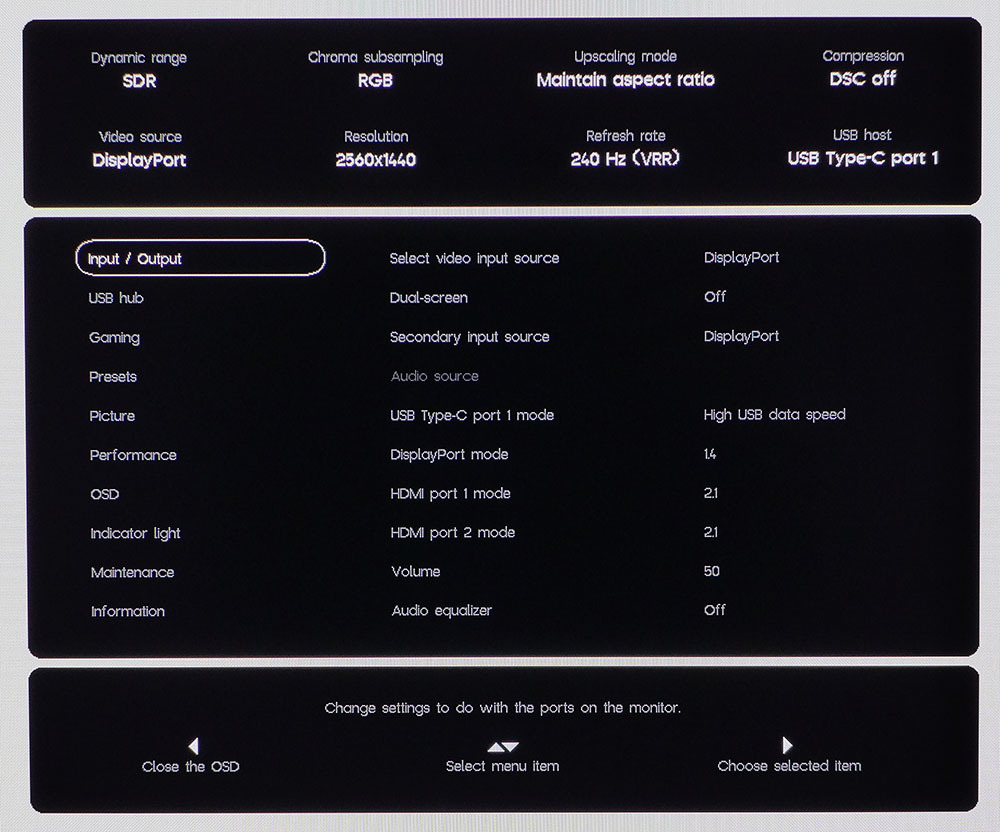
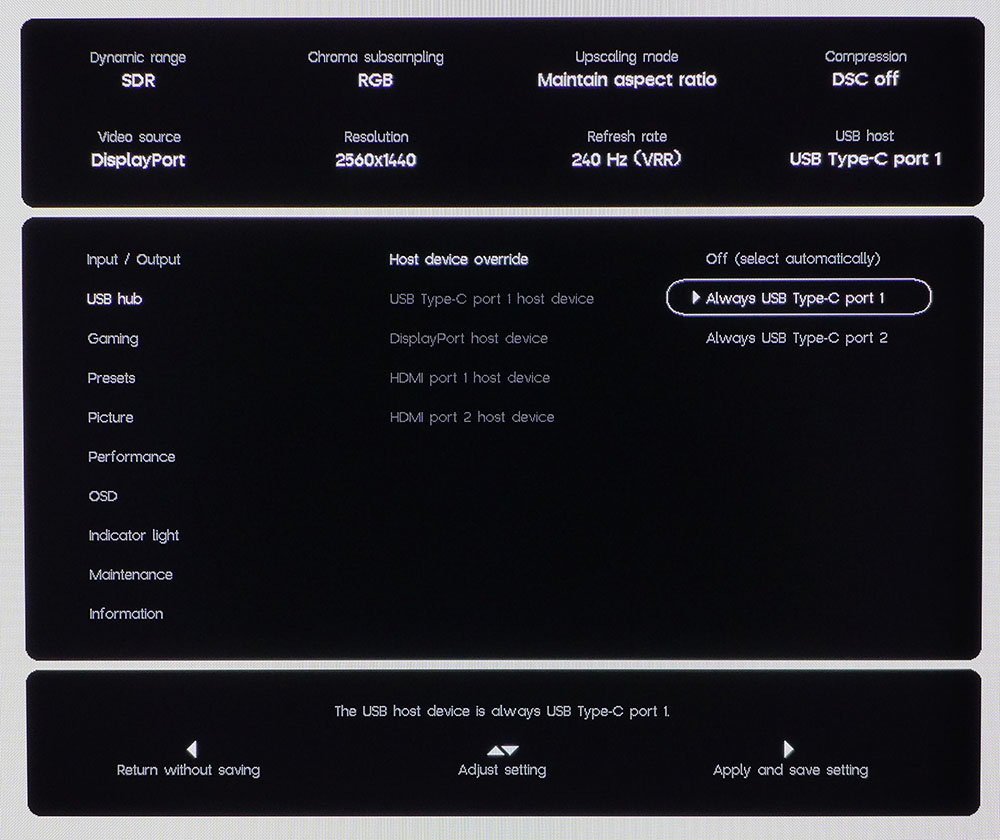
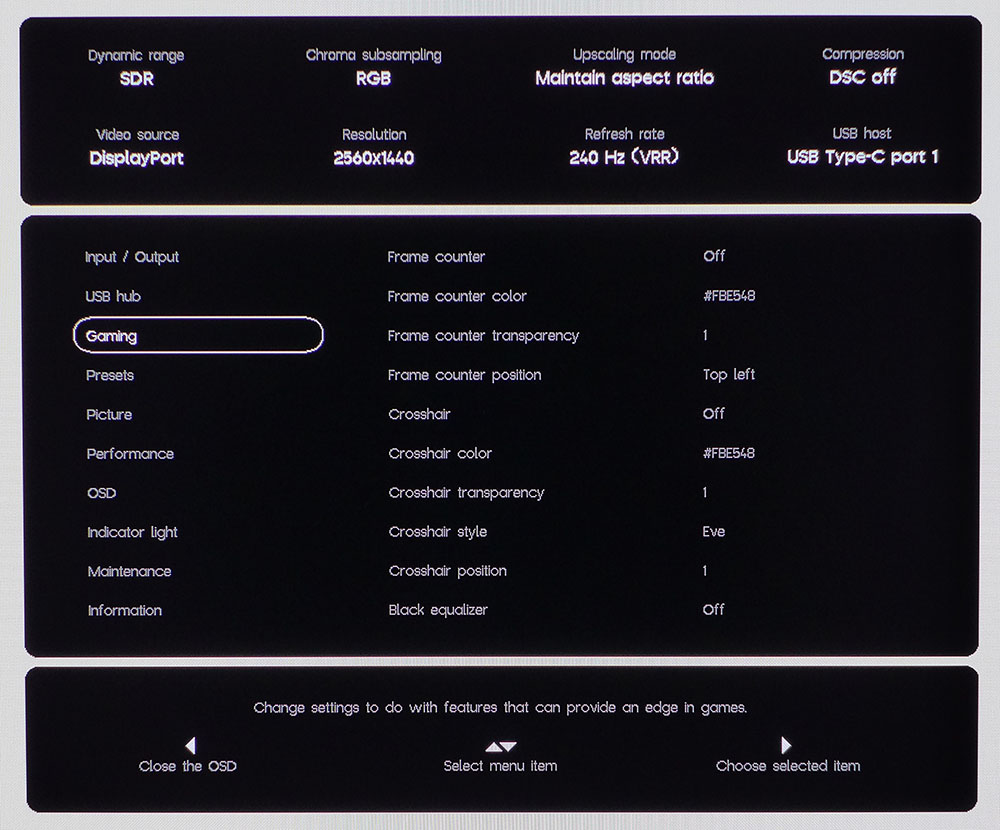


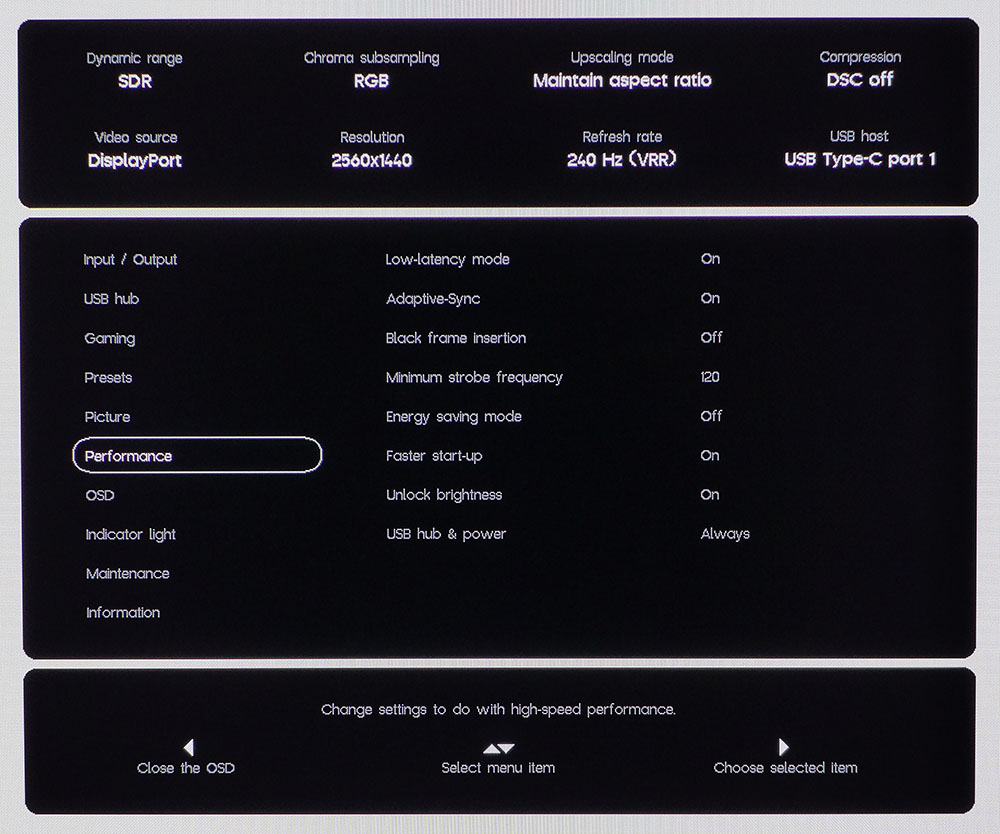
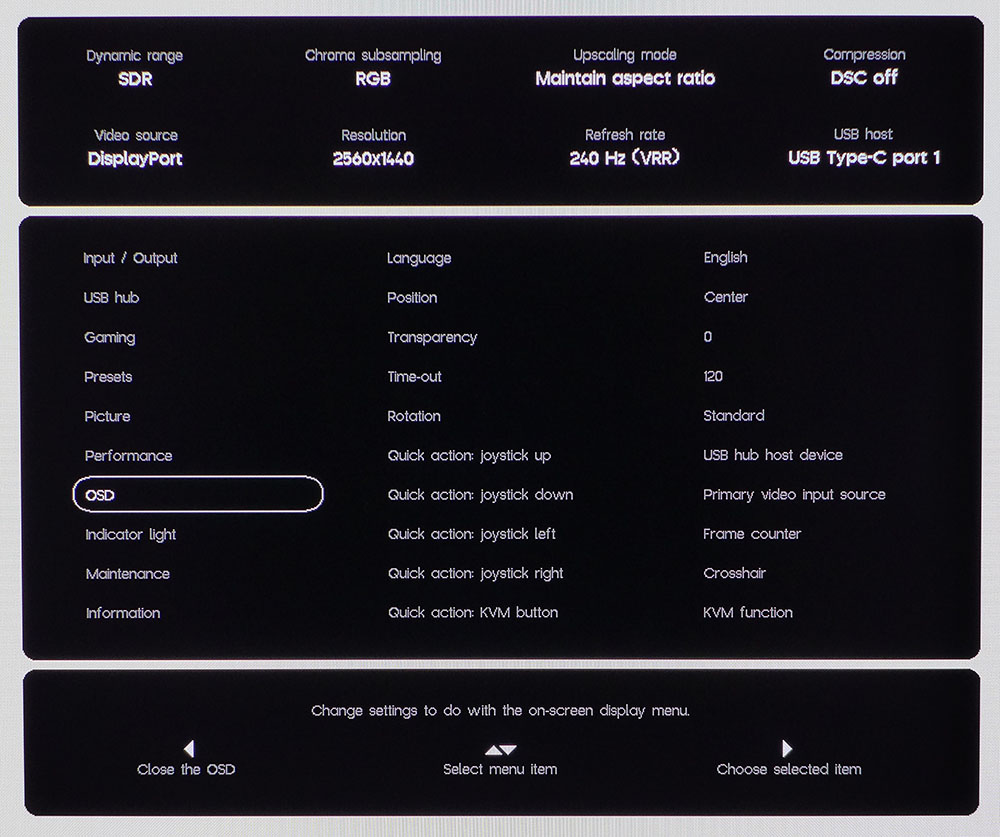

The Spectrum Black 27’s input selector does far more than switch video. You can specify port versions for each interface and control the USB ports too. You also get the PBP/PIP options here to view two sources simultaneously. It’s followed by the USB hub controls, which can be configured in many different ways. Once set up, you can switch with the dedicated KVM button below the joystick.
The Gaming menu has a frame counter and a selection of aiming points. Colors can be any combination of RGB values, which means there are over 16 million possibilities. You also get a black equalizer, which can help make shadow detail more visible.
I wish all monitors had the Presets menu. Rather than picture modes with labels, there are three settings memories and an option to reset everything back to factory defaults. It's very simple, very easy, and very precise.
You won’t have to spend much time tweaking color because each Spectrum Black 27 includes its own factory calibration. What’s important in the Picture menu are the Brightness Modes. All OLEDs have this to some degree. If you want steady brightness throughout, choose Uniform Brightness. The picture won’t be as bright but won’t vary with content. Tempered Brightness favors highlights over other parts of the image, providing more punch. Maximum Brightness varies output evenly across the range and, therefore, sticks to correct SDR gamma and HDR EOTF values. If you want to tweak color temp and gamma here, presets and RGB sliders are provided.
The Performance menu has video processing options like low-latency and Adaptive-Sync toggle. Black Frame insertion, also known as ELMB and blur reduction, can be employed at speeds up to 120 Hz with a variable strobe frequency. It reduces blur at the expense of brightness, less blur means less light. If you can drive the Spectrum Black 27 over 120fps, it isn’t necessary. It also deletes Adaptive-Sync.
The joystick directionals can be programmed to provide quick access to different options. You can also specify the action of the KVM button. The menu can occupy different positions, have variable transparency, and stay on for up to two minutes. It can be rotated between portrait and landscape modes.
Dough has included a comprehensive set of OLED maintenance options. There is pixel shift, a screen saver, logo compensation, and others. Each one is explained at the bottom, so you know what it does. The last two, transistor wear and OLED wear compensation, take about five minutes to complete and can be run whenever you wish.
Dough Spectrum Black 27 Calibration Settings
When I measured my Spectrum Black 27 sample, it hit all the marks near perfection. I could not improve upon the numbers with calibration, so I left them at the factory defaults. I found the best picture and the best test results with Brightness Mode on Maximum. This varies brightness uniformly across the full image range, so you won’t see it in operation. If you need a stable light output level, choose Uniform brightness. You can change gamut modes between DCI-P3, Adobe RGB and sRGB without affecting other parameters. Adobe RGB is off the mark for green and, while fine for casual use, is not accurate enough for critical applications. However, P3 and sRGB are qualified. My suggested settings are below.
In HDR mode, all image controls are available except for gamma. You can change the brightness mode, alter peak brightness, change color temperature, and even change the color gamut. The best image is with factory defaults in place, with Brightness mode on Maximum and the slider at 100.
| Color Mode | P3 or sRGB |
| Brightness 200 nits | 37 |
| Brightness 120 nits | 21 |
| Brightness 100 nits | 17 |
| Brightness 80 nits | 13 |
| Brightness 50 nits | 7 (min. 25 nits) |
| Brightness Mode | Maximum Brightness |
| Contrast | 50 |
| Gamma | 2.2 |
| Color Temp | Normal |
Gaming and Hands-on
The Spectrum Black 27’s main selling point is its Gorilla Glass front layer, which is supposed to make blacks deeper. OLED blacks are already about as black as can be, so, in practice, this is a subtle thing. Lining up an Alienware AW3225QF 32-inch display next to it made the Dough look slightly blacker. It’s subtle, and it depends on how ambient light hits the screen. But the Gorilla Glass makes a positive impact. Though it is shiny, it is also coated to reduce glare and it does this effectively. I liked the way it resisted fingerprints too. Though I am not a screen toucher, other users I know frequently touch the screen when pointing things out. It drives me crazy, but it’s a thing. I would pay the extra $200 for Gorilla Glass over a matte finish.
The Spectrum Black 27’s size and shape are ideal for all tasks, work and play. I have no preference for curved versus flat, but in a smaller size, like 27-inch 16:9, flat makes more sense for how I interact with a computer. The image is stunning in every respect. Thanks to the Gorilla Glass, it’s super sharp, a little more so than others. Color and contrast are vivid and bright. There’s plenty of juice for SDR content, more than you’ll need, but a bit of headroom is nice. After trying the three different brightness modes, I settled on Maximum as the best choice. I could not see any output shift during work or gameplay.
The Spectrum Black 27 is marketed as a gaming monitor, and it is perfect for this task. At speeds over 200fps, motion resolution is perfect, no different from the static image. Fast-moving objects and backgrounds retain every detail, no matter how fast you move the mouse. There is no perceptible input lag, either. I measured 21ms in testing, which is up with the quickest monitors currently available (including 500 and 540 Hz models).
To try out the black frame insertion feature, I dropped the refresh rate to 120 Hz, which is its maximum. From this point, you can adjust the strobe frequency, equivalent to pulse width for an LCD, to fine-tune the blur reduction level versus the light level. I cranked it to 120 and upped the brightness to compensate. The picture was more than bright enough, and motion blur was completely eliminated. This is a great feature for systems that can’t drive the Spectrum Black 27 faster than 200fps. Though OLED is smoother than LCD at equal refresh rates, it will show some blur below that speed.
While many users gravitate to Ultra HD and its higher pixel density, the Spectrum Black 27 makes the most of its 109ppi with a super sharp image. OLED contrast significantly ups the dimensionality and perception of sharpness. If you put a 27-inch QHD LCD next to it, the Spectrum Black 27 is significantly clearer thanks to its tremendous contrast and optically pure front glass.
I was very impressed with the Spectrum Black 27’s build quality and physical feel. The stand is rock solid despite its slim appearance. The panel is slender too but has no flex, nor does it creak when moved. This is a premium display in every respect.
Takeaway: The Spectrum Black 27 is more expensive than its competition when you go for the Gorilla Glass option with a stand. But you get a slightly sharper image with blacks that do indeed look slightly blacker. You also get top-notch build quality that meets or exceeds the standard set by the best monitors I’ve reviewed. Gaming performance is at the top of the class with perfect motion resolution, a strobing option, and input lag on par with the fastest displays available. The Spectrum Black 27 does everything well.
MORE: Best Gaming Monitors
MORE: How We Test PC Monitors
MORE: How to Buy a PC Monitor
MORE: How to Choose the Best HDR Monitor
Current page: Features and Specifications
Next Page Response, Input Lag, Viewing Angles and Uniformity
Christian Eberle is a Contributing Editor for Tom's Hardware US. He's a veteran reviewer of A/V equipment, specializing in monitors. Christian began his obsession with tech when he built his first PC in 1991, a 286 running DOS 3.0 at a blazing 12MHz. In 2006, he undertook training from the Imaging Science Foundation in video calibration and testing and thus started a passion for precise imaging that persists to this day. He is also a professional musician with a degree from the New England Conservatory as a classical bassoonist which he used to good effect as a performer with the West Point Army Band from 1987 to 2013. He enjoys watching movies and listening to high-end audio in his custom-built home theater and can be seen riding trails near his home on a race-ready ICE VTX recumbent trike. Christian enjoys the endless summer in Florida where he lives with his wife and Chihuahua and plays with orchestras around the state.
-
azcn2503 This review mentions nothing about actually trying to obtain one of these things. Customers that placed orders literally years ago have not received their product yet, and the company have gone dark with their communications. There is some very shady activity happening with the company filing for various types of insolvency, changing their name, etc. to exploit loopholes that aid protecting them from engaging with and reimbursing very rightfully enraged customers.Reply
Dough were previously known as Eve. A quick google search for simply "dough eve" will tell you everything you need to know about this network of companies. -
j99992 Reply
Even better, consider using DuckDuckGo or Brave Search. Remember, there are multiple search engines available worldwide.azcn2503 said:Dough were previously known as Eve. A quick google search for simply "dough eve" will tell you everything you need to know about this network of companies.
What baffles me is that OLED is still discussed and priced as if it's a brand-new, cutting-edge technology, despite being around for about 20 years. I was anticipating OLED back in 2003. -
helper800 Reply
The problem that still exists with OLED is the manufacturing cost. It is a very expensive BOM technology, just because its 20 years old does not automagically make manufacturing it any cheaper, especially at these small screen sizes.j99992 said:Even better, consider using DuckDuckGo or Brave Search. Remember, there are multiple search engines available worldwide.
What baffles me is that OLED is still discussed and priced as if it's a brand-new, cutting-edge technology, despite being around for about 20 years. I was anticipating OLED back in 2003. -
parkerthon If you don’t understand why this monitor is so expensive, you don’t understand why people buy premium monitors.Reply
I find it humorous when people build a $2000 gaming pc only to spend $200 on a va panel that looks like washed out dog crap or a laggy ips that looks like a blurry slide show when gaming. But then again I notice this stuff because I have always felt the monitor is key to the whole pc gaming experience. I know others could care less. Just understand, this price is justified. -
Jamesar Reply
I can confirm this is still an issue in 2025. I purchased a 32" OLED monitor directly from Dough's website in August 2023 and never received it because of production delays. The order was cancelled in August 2024, but I never received a refund and customer support stopped responding to my requests for a refund. I'm still out over $950 and have no way to get my money back.azcn2503 said:This review mentions nothing about actually trying to obtain one of these things. Customers that placed orders literally years ago have not received their product yet, and the company have gone dark with their communications. There is some very shady activity happening with the company filing for various types of insolvency, changing their name, etc. to exploit loopholes that aid protecting them from engaging with and reimbursing very rightfully enraged customers.
Dough were previously known as Eve. A quick google search for simply "dough eve" will tell you everything you need to know about this network of companies. -
helper800 Reply
You should initiate a chargeback on the card for the purchase.Jamesar said:I can confirm this is still an issue in 2025. I purchased a 32" OLED monitor directly from Dough's website in August 2023 and never received it because of production delays. The order was cancelled in August 2024, but I never received a refund and customer support stopped responding to my requests for a refund. I'm still out over $950 and have no way to get my money back.
